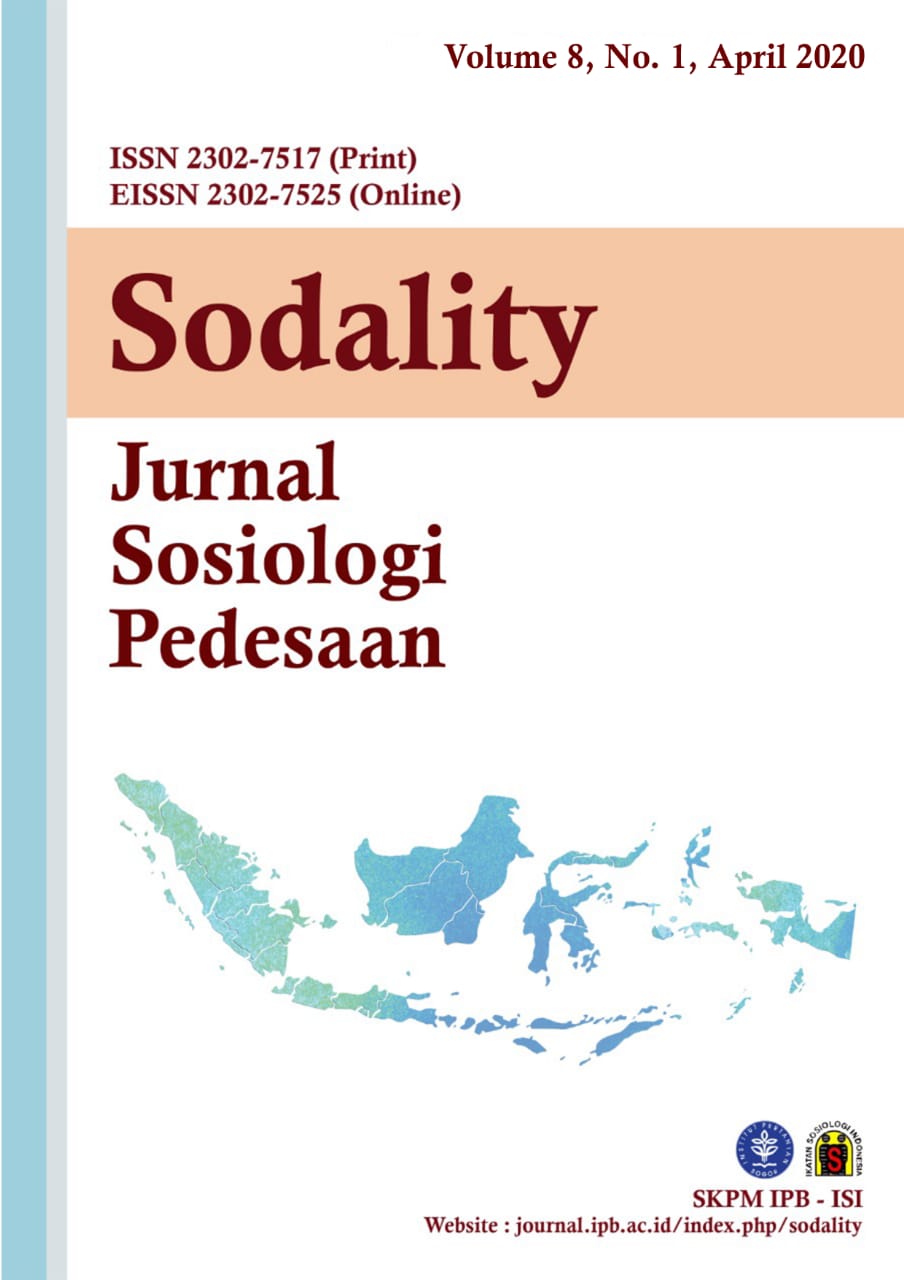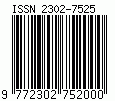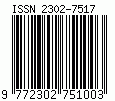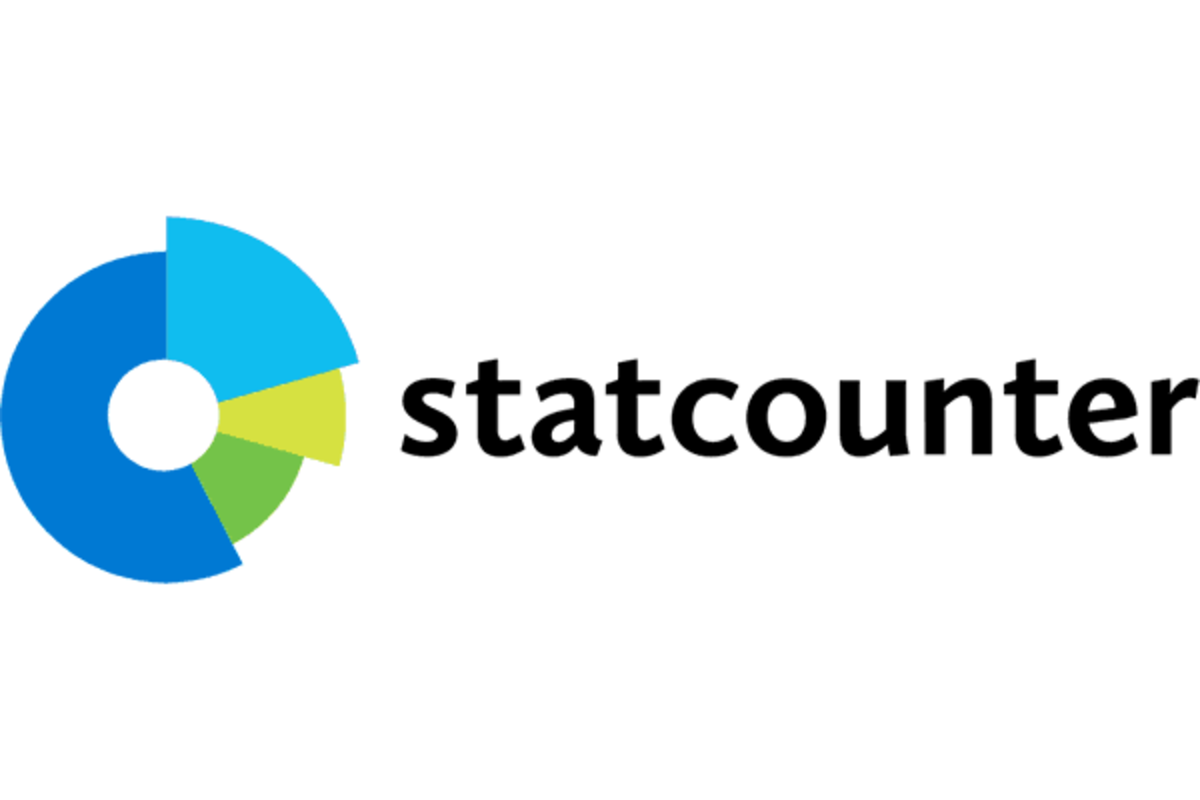Could PES Change the Agrarian Structure? a Lesson Learned of Citaman Village, Banten
Abstract
This study aimed to analyze changes in the agrarian structure in Citaman Village, whether or not capitalists enters the formation of community land, after payment for Environmental Services (PES) mechanism is effective. This research relies on the constructivism paradigm, using qualitative method. The primary data was collected through in-depth interviews and focus groups discussion, with farmer groups, community leaders and related parties. Relevant secondary data was also collected. The results show that: First the PES program which has been running for more than 15 years, has not changed the agrarian structure significantly in Citaman Village. The agricultural land is still dominantly controlled and owned by Citaman Village residents. Second the changes that occurred as a PES program were found in the patterns of agricultural land use. Agricultural land that was originally used for upland rice cultivation or huma is now turned into an agroforestry area.
References
Borner, J. Baylis, K. Corbera, E. Ezzine-de-Blas, D. Honey-Roses, J. Person, UM dan Wunder, S. 2017. The Effectiveness of Payments for Environmental Services. Elsevier. Vol 96, 359-374.
Creswell, JW. 2014. Penelitian Kualitatif dan Desain Riset. Yogyakarta (ID): Pustaka Pelajar.
Das, R. 2017. David Harvey’s Theory of Accumulation by Dispossession: A Marxist Critique. World Review of Political Economy.Vol 8/4,pp: 590-616.
Fripp, E. 2014. Payment For Ecosystem Services: A Practical Guide to Assesing The Feasibility of Pes Project. [internet] [diakses pada 06 november 2018] diunduh dari:http://www.cifor.org/publications/pdf_files/Books/BFripp1401.pdf.
Halimatusadiah, S. Dharmawan, AH. Mardiana R. 2012. Efektifitas Kelembagaan Partisipatoris di Hulu Daerah Aliran Sungai Citarum. Sodality. ISSN: 1978-4333, Vol. 06, No. 01, 70-90.
He, S. Su, Y. Wang, L. Gallagher, L. dan Cheng, H. 2018. Taking an Ecosystem Services Approach for A New National Park System in China. Elsevier. Vol 137, 136-144.
Hidayat. 2011. Perubahan Struktur Agraria Di Hulu Das Cidanau Kabupaten Serang Provinsi Banten. AGRICHEP. ISSN: 1412-8837, Vol. 10. No. 01, 94-112.
Kosoy, S. Corbera, E. 2010. Payments for Ecosystem Services as Commodity Fetishism. Elsevier. Vol 69, 1228-1236.
Laila, N. Murtilaksono, K dan Nugroho, B. 2014. Kelembagaan Kemitraan Hulu Hilir untuk Pasokan Air DAS Cidanau, Provinsi Banten. JURNAL. Vol. 11, No. 2, 137-152.
Lestari, A. Dharmawan, AH. 2011. Dampak Sosio-Ekonomis dan Sosio-Ekologis Konversi Lahan. Sodality. ISSN: 1978-4333, Vol. 05, No. 01, 01-12.
Fauzi, A. Leimona, B. dan Muhtadi. 2005. Strategi Pengembangan Pembayaran dan Imbal Jasa Lingkungan di Indonesia. [internet] [diakses pada 31 oktober 2018] diunduh dari: http://www.worldagroforestry.org/downloads/Publications/PDFS/pr13960.pdf.
Martin-Ortega, J. Ojea, E. dan Roux, C. 2013. Payments for Water Ecosystem Services in Latin America: A Literature Review and Conceptual Model. Elsevier, Vol. 06, 122-132.
Sihaloho, M. Dharmawan, AH. Rusli, S. 2007. Konversi Lahan Pertanian dan Perubahan Struktur Agraria. Sodality. ISSN: 1978-4333, Vol. 01, No. 02, 253-270.
Mol, APJ. 1995. The Refinement of Production. [internet] [diakses pada 05 januari 2019] diunduh dari: https://www.researchgate.net/publication/261988444_The_Refinement_of_Production_Ecological_Modernization_Theory_and_The_Chemical_Industry?enrichId=rgreq-8e3727aedda92c8eb76d4d2d5b97c9d6-XXX&enrichSource=Y292ZXJQYWdlOzI2MTk4ODQ0NDtBUzo5OTUyNzkxMDQ5NDIyN0AxNDAwNzQwNzExNzkw&el=1_x_2&_esc=publicationCoverPdf.
Mol, A PJ and Spaargaren, G. 2000. Ecological Modernisation Theori in Debate: A Review Enviromental Politics. University Library Utrecht. Vol. 9, No. 1, 17-49.
Moore, BJR. 1966. Social Origins of Dictatorship And Democracy Lord And Peasant in The Making of The Modern World. U.S.A: PENGUIN UNIVERSITY BOOKS.
Motta, RSD dan Ortis, RA. 2018. Costs and Perceptions Conditioning Willingness to Accept Payments for Ecosystem Services in A Brazilian Case. Elsevier. Vol. 147, 333-342.
Neuman, WL. 2013. Metodologi Penelitian Sosial: Pendekatan kualitatif dan Kuantitatif. Edina T, Sofia; Penerjemah. Jakarta (ID): PT.Indeks.
Noordwijk, MV. Leimona, B. 2010. Principles for Fairness and Efficiency in Enhancing Environmental Services in Asia: Payments, Compensation, or Co-Investment? E&S. Vol. 15, No. 4.
Pagiola S, 2007. Payments for Environmental Services in Costa Rica. Elsevier. Vol 65, 712-724.
Pagiola, S. Ramires, E. Gobbi, J. Haan, CD. Ibrahim, M. Murgueitio, E. Ruiz, JP. 2007. Paying for the Environmental Services of Silvopastoral Practices in Nicaragua. Elsevier. Vol. 64, 374-385.
Pattanayak, SK. Wunder, S. Ferraro, PJ. 2010. Show Me The Money: Do Payments Supply Environmental Services in Developing Countries? Oxford Journal. Vol. 4, No 2, 254-274.
Popkin, SL. Petani Rasional. Jakarta (ID): LEMBAGA YAYASAN PADAMU NEGERI.
Rachman, NF. 2017. Petani dan Penguasa. Yogyakarta (ID): INSISTPress.
Sattler, C. Trampnau, S. Schomers, S. Mayer, C. Matzdorf, B. 2013. Multi-Classification of Payments for Ecosystem Services: How DoClassification Characteristics Relate to Overall PES Success? Elsevier. Vol. 6, 31-45.
Sitorus, MTF. 2002. Lingkup Agraria. Di dalam: Suhendar E, et al, penyunting. Menuju Keadilan Agraria: 70 Tahun Gunawan Wiradi. Bandung (ID): ARKATIGA.
Sanches-azofeifa, GA. Praff, A. Robalino, JA. Boomhower, JP. 2007. Costa Rica’s Payment for Environmental Services Program: Intention, Implementation, and Impact. Conservation Biologi. Vol 21. No. 5, 1165-1173.
Schomers, S. Matzdorf, B. 2013. Payments for Ecosystem Services: A Review and Comparison of Developing and Industrialized Countries. Elsevier. Vol 6, 16-30.
Svarstad, H. Sletten, A. Paloniemi, R. Barton, DN dan Grieg-Gran, M. 2011. Three types of environmental justice - From concepts to empirical studies of social impacts of policy instruments for conservation of biodiversity. Policymix. [internet] [diakses pada 23 juli 2019] diunduh dari: https://www.nina.no/archive/nina/PppBasePdf/Policymix%20Report/Svarstad%20Three%20POLICYMIX%20Report%201%202011.pdf.
Tridakusuma, AC. Soetarto, E. Adiwibowo, S dan Sriwahyuni, E. 2019. Senjakala Agraria di Pedesaan Jawa Barat: Dari Akumulasi ke Esklusi. Sodality. ISSN: 1978-4333, Vol. 80, 78-85.
Wiradi. 1984. Pola Penguasaan Tanah dan Reforma Agraria, dalam Sediono M.P. Tjondronegoro dan Gunawan Wiradi, editor. Seri Pembangunan Pedesaan: Dua Abad Penguasaan Tanah (Pola Penguasaan Tanah Pertanian di Jawa dari Masa ke Masa). Jakarta (ID): PT. Gramedia.
Wiradi, G. 2009. Seluk Beluk Masalah Agraria: Reforma Agraria dan Penelitian Agraria. Yogyakarta (ID). STPN Press.
Wiradi, G dan Makali. 1984. Penguasaan Tanah dan Kelembagaan dalam Faisal Kasryono, editor. Prospek Pembangunan Ekonomi Pedesaan Indonesia. Jakarta (ID): Yayasan Obor Indonesia.
Wunder, S. 2007. The Efficiency of Payments for Environmental Services in Tropical Conservation. Conservasion Biologi. Vol. 21. No. 1, 48-58.
Wunder, S. Engel, S. Pagiola, S. 2008. Taking Stock: A Comparative Analysis of Payments for Environmental Services Programs In Developed and Developing Countries. Elsevier. Vol. 65, 834-852.
Wunscher, T. Angel, S. Wunder, S. 2008. Spatial Targeting of Payments for Environmental Services: A Tool for Boosting Conservation Benefits. Elsevier. Vol. 65, 822-833.
Zabel, A. Angel, S. 2010. Performance Payments: A New Strategy to Conserve Large Carnivores in the Tropics? Elsevier. Vol. 70, 405-412.
Authors who publish with this journal agree to the following terms:
- Authors retain copyright and grant the journal right of first publication with the work simultaneously licensed under a

This work is licensed under a Creative Commons Attribution 4.0 International License. that allows others to share the work with an acknowledgement of the work's authorship and initial publication in this journal. - Authors are able to enter into separate, additional contractual arrangements for the non-exclusive distribution of the journal's published version of the work (e.g., post it to an institutional repository or publish it in a book), with an acknowledgement of its initial publication in this journal.
- Authors are permitted and encouraged to post their work online (e.g., in institutional repositories or on their website) prior to and during the submission process, as it can lead to productive exchanges, as well as earlier and greater citation of published work (See The Effect of Open Access).





.png)










